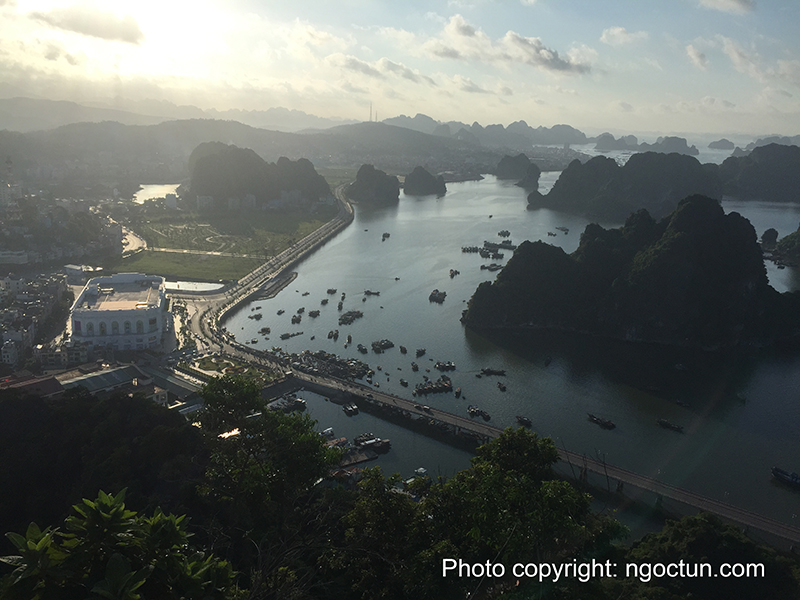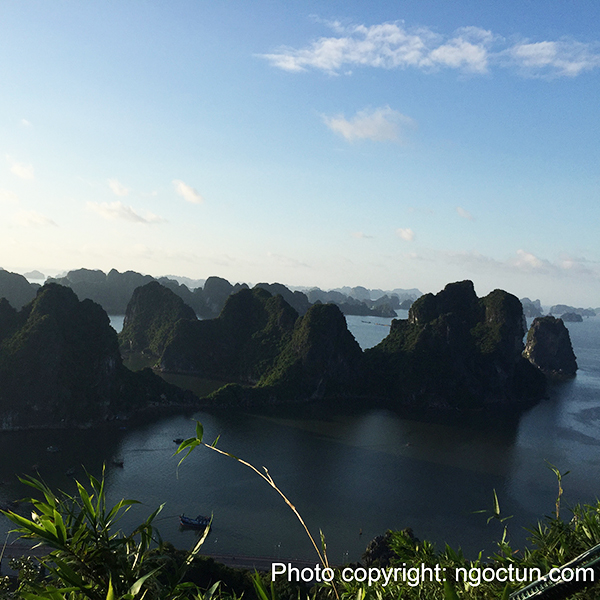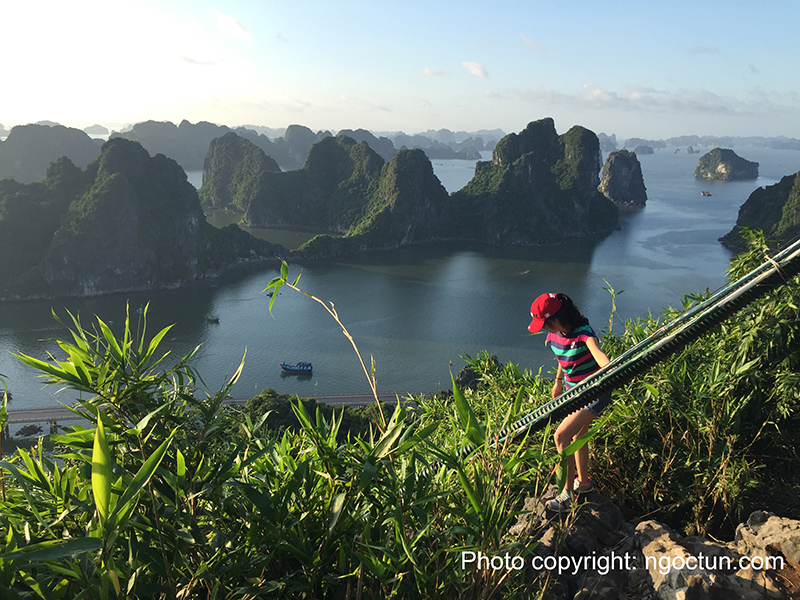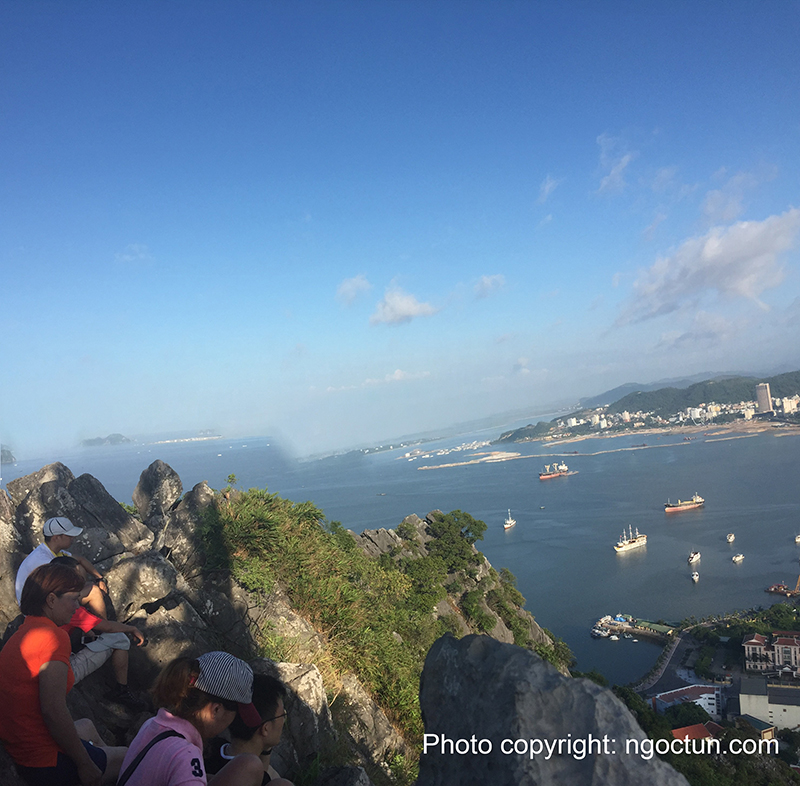
Contemplating Poem Mountain in Halong Bay
With so many wonderful cruise options in Halong Bay, it is easy to forget that there is more to this destination than just cruise ships. Ngoc Le takes us to Poem Mountain, which is as historically significant as it is picturesque.
Bai Tho, which is ‘poem’ in Vietnamese, is a 200-metre-high coastal limestone mountain located within Halong City. It is recognized as a national relic and can be the ideal spot to cast your view over Halong Bay and the city that shares its name. The mountain can be seen as a standing tiger, a hunting lion and a flying dragon depending on the angle from which it is viewed.
The mountain’s name has its own unique history and special story. Its original name is Truyen Dang Mountain, which translates to ‘alarming by light’ and it is fabled to have played an important role in protecting the country. A soldier troop on the top of the mountain made a fire every night to help boats to dock, and if there was a threat from invaders, the fires were used to warn the city.
In the spring of 1468, it is said that king Le Thanh Tong patrolled the northeast coast and stopped at the mountain to drink wine and throw himself into his poetry after being inspired by the spectacular views of the Bay and the city. His poem was then engraved on a big flat stone on top of Truyen Dang Mountain. 261 years later, Trinh Cuong, a famous poet in the Le-Trinh age, visited the mountain. After being inspired by the poem of the King and the stunning natural scenery, he composed his own poem. In the early years of the 20th century, many famous poets went there and composed poem after poem, all inspired by the spectacular views of the Bay. And so the name of the mountain came to be known as Bai Tho, or ‘poem’.
The mountain safeguarded the country not only during feudalistic history, but also throughout the 20th century. In May of 1930, the red flag with the yellow hammer and sickle flew on the top of Bai Tho Mountain, marking an important period in Halong’s history when the Nghe-Tinh Soviet Movement challenged the French occupation. The flag still flies high and has since become the symbol of Halong city.
In the Vietnamese war against the US, a Vietnamese militia troop from Bach Dang District set up a 12.7mm artillery base at the foot of the mountain, which contributed to several local victories. At that time, thanks to its special geographical location, the mountain was used as an air defense watch, a first aid office, a warning post, and a post office, while the caves beneath were used for evacuation purposes.
Today the mountain can be easily climbed. There are two entranceways to hike on the mountain: the first one is from the lane near Long Tien pagoda in Long Tien street, and the second from a small lane in Hang Noi street.
Even though the mountain is not so high, it can be quite hard to reach the peak because of its sharp cliffs; luckily, the stone steps make it easier. The weather is usually quite cool, even in the summer, so don’t let the heat put you off. On the way you will hear birds singing, see goats grazing freely and if you’re lucky, you might see monkeys perching on the trees and calling to one another. After a 30-minute climb, you will have reached the peak where you can find the stone with the poem of the king and the flagpole.
Always remember to wear a good pair of shoes, long pants, and to bring water and some snacks.
Around the mountain
All within just 1 km from Bai Tho Mountain, you can also discover Long Tien pagoda, bridges, markets and a post office. Long Tien, the biggest pagoda in Halong city, is seventy years old and leans with its back against the mountain. When visiting the pagoda you can burn incense to wish for good health and happiness, enjoy the quiet view and the ancient atmosphere that is now hard to find in modern Vietnam. Nearby are the Bai Tho bridges, which have only been recently built and offer gorgeous coastal views.
Halong market is the city’s biggest commercial center selling a variety of local products including souvenirs, clothing, electronics and fresh seafood. The price is reasonable but you need to bargain, and you may find this a more interesting local experience visiting the night market in Bai Chay.
The telegraph transmission center of the Quang Ninh provincial post office is now located at the northern flank of the mountain but during the Vietnamese war against the US, the center was moved to the caves at the eastern flank of the mountain. From this position of relative security, important information was transmitted which helped to fight against US aircraft. The center can still be visited and serves as an interesting reminder of the province’s history.
About the writer
Ngoc is working for NGOs in Vietnam. She loves travelling and learning about cultures, which encourages her to write travel articles contained culture knowledge. Ngoc is a dog lover, having her own a golden retriever named Tun. She is also interested in animal welfare and manages a website which provides free information about caring and training dogs and cats for Vietnamese read


